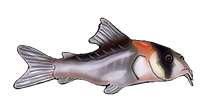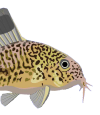| Scientific Name | Pterygoplichthys lituratus (Kner, 1854) |
| Common Names | L196, Fatamorgana Pleco Fatamorgana-sugemalle (Denmark) |
| Type Locality | Rio Guapore near Mato Grosso, Amazon system, Brazil. |
| Synonym(s) | Ancistrus lituratus, Glyptoperichthys lituratus |
| Pronunciation | terry gop LICK thees |
| Etymology | Greek, pterygion, diminutive of pteryx = wing, fin + Greek, hoplon = weapon + Greek, ichthys = fish. |
| Size | 370mm or 14.6" SL. Find near, nearer or same sized spp. |
| Identification | Pterygoplichthys can be identified by the number of rays in the dorsal fin. Ten or more dorsal rays (usually more than 10) indicates that it's a Pterygoplichthys. Most other plecos have 8 or fewer rays (in particular the larger Hypostomus species that are most likely to be confused with Pterygoplichthys). Pterygoplichthys lituratus has a dark brown body with light tan reticulated lines. P. lituratus bears a similar appearance with P. joselimaianus and P. parnaibae. The three are collected from different waterways, with P. lituratus originating in the Rio Madiera basin, states of Rondonia and Mato Grosso, P. joselimaianus originating in the Rio Tocantins basin in the state of Goias, and P. parnaibae originating in the Rio Parnaiba basin in the state of Maranhao. Also P. lituratus is the largest of the three species, based on recorded sizes. |
| Sexing | Comparison of the genital papilla in mature fish shows the differences in the sexes to the trained eye. In males this is a small yet thick stump which noticeably protrudes from the fish's undercarriage. In females it is less obvious and is recessed or lies flat with the body. |
| Distribution | South America: Madeira River basin. Amazon, Middle Amazon (Solimoes), Madeira (click on these areas to find other species found there) Amazon, Middle Amazon (Solimoes), Madeira, Mamoré, Guaporé (Iténez) (click on these areas to find other species found there) Login to view the map. |
| IUCN Red List Category | Least Concern , range map and more is available on the IUCN species page. Last assessed 2020. |
| Feeding | Omnivorous and a good algae eater, especially when young. User data. |
| Suggested Tankmates | Almost any medium sized community fish. |
| Breeding | Unreported in captivity, in nature, the male fish occupies a tunnel in soft river bank in which the eggs are laid and guarded. The egg mass of bright orange eggs contains thousands of eggs. |
| Breeding Reports | There is but a single breeding report, read it here. |
| Reference | Denkschriften der Kaiserlichen Akademie der Wissenschaften in Wien, Mathematisch-Naturwissenschaftliche Classe. v. 7, pp 285 [35], Pl. 5 (fig. 3). |
| Registered Keepers | There is but a single registered keeper, view all "my cats" data. |
| Wishlists | Love this species? Click the heart to add it to your wish list. There is no wish to keep this species. |
| Spotters | Spotted this species somewhere? Click the binoculars! There are 2 records of this fish being seen, view them all. |
| Forum BBCode | |
| Search for P. lituratus | |
| Look up P. lituratus on AquaticRepublic.com | |
 | Look up P. lituratus on Fishbase |
 | Look up P. lituratus on Encyclopedia of Life |
 | Look up P. lituratus on Global Biodiversity Information Facility |
| LFS label creator ARN ref:1.4.6.809 | |
| Last Update | 2025 Jan 01 12:10 (species record created: 2007 Feb 23 21:13) |





/siluriformes/loricariidae/pterygoplichthys/lituratus/1.jpg)
/siluriformes/loricariidae/pterygoplichthys/lituratus/2.jpg)
/siluriformes/loricariidae/pterygoplichthys/lituratus/3.jpg)
/siluriformes/loricariidae/pterygoplichthys/lituratus/4.jpg)
/siluriformes/loricariidae/pterygoplichthys/lituratus/5.jpg)
/siluriformes/loricariidae/pterygoplichthys/lituratus/6.jpg)